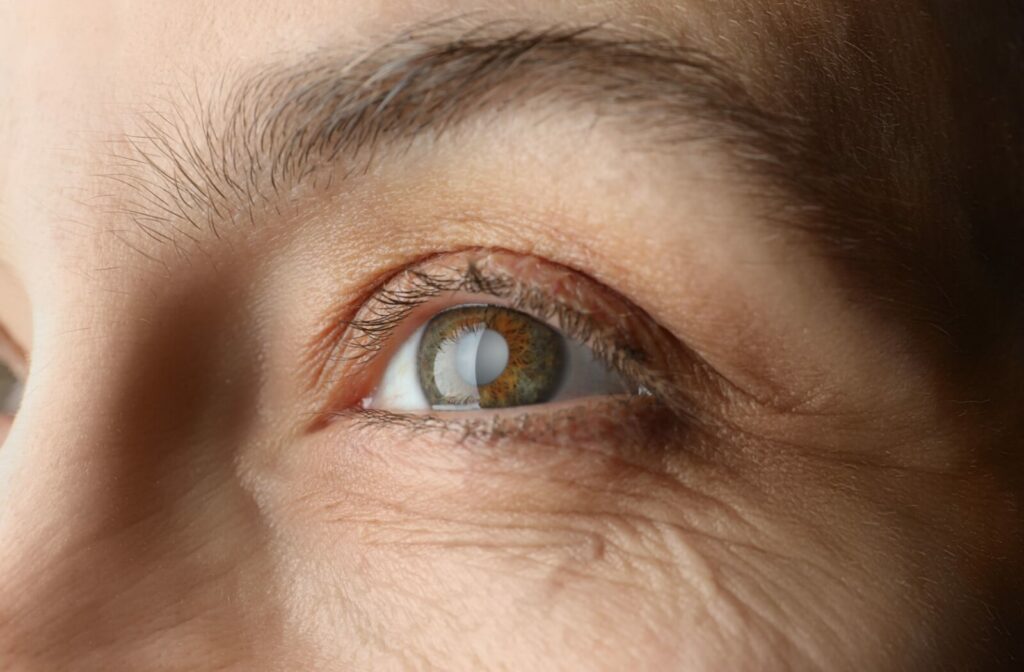Vision is one of our most important senses, but as we grow older, it can become affected by age-related conditions like cataracts. Recognizing the first signs of cataracts, which include blurry or cloudy vision, light sensitivity, and fading colours, can make a significant difference in management. Prompt action ensures that your eyes remain as healthy as possible.
Cataracts are a leading cause of vision impairment worldwide, especially in older adults. However, they can typically be easily managed through prescription glasses or a safe and effective surgery that replaces the natural lens of your eye.
Your eye doctor can also detect developing cataracts during a comprehensive eye examination.
The Early Signs of Cataracts
The development of cataracts is typically slow and subtle, meaning that symptoms can creep up on you without much warning.
Blurry or Cloudy Vision
A common and recognizable early symptom of cataracts is blurry or cloudy vision. This occurs because cataracts cause proteins in the lens of your eye to break down and clump together, clouding the lens and interfering with light as it enters the eye. At first, you might notice that your vision looks slightly “off,” like you’re peering through fog or a smudged window.
Tasks requiring sharp vision, such as reading fine print or recognizing faces from a distance, may become increasingly challenging. This cloudiness will typically continue to worsen over time, significantly impacting your daily life.
Increased Sensitivity to Light
Another common early indicator is increased sensitivity to light. Bright sunlight, car headlights, or even indoor lighting might suddenly feel overwhelming or uncomfortable. For some, this can lead to difficulty driving at night due to the glare of headlights or halos that appear around light sources.
This heightened sensitivity can make everyday tasks more difficult and is often one of the first symptoms that prompt people to visit their eye doctor.
Fading or Yellowing Colours
Have the vibrant colours you adore started appearing dull or washed out? Cataracts can affect your ability to perceive colours, making them appear faded or yellowish. Whites may seem more beige, reds less bright, and the overall vibrancy of the world may start to fade.
This change in colour perception may be subtle at first, but it can become increasingly noticeable and impact activities such as selecting clothing, appreciating artwork, or even identifying ripe fruit.

Why Do Cataracts Develop?
Cataracts are often a natural part of aging, typically developing slowly over time. They occur when proteins in the eye’s lens break down and clump together, causing the lens to cloud and impair vision. But age isn’t the only factor. Several other variables can contribute to their development, including:
- Genetics: If cataracts run in your family, your chances of developing them may be higher
- Prolonged UV exposure: Spending excessive time in the sun without proper eye protection can accelerate the formation of cataracts
- Lifestyle choices: Smoking and poor diet habits can increase the likelihood of developing cataracts
- Medical conditions: Conditions like diabetes are linked to a heightened risk of cataract formation
- Eye injuries or surgeries: Trauma or surgeries that affect the eye can prompt cataracts to form
Understanding these risk factors helps highlight the importance of regular eye exams, especially as you age.
Understanding Cataract Surgery
If cataracts significantly impair your vision or quality of life, your eye doctor may recommend cataract surgery. Fortunately, it’s one of the safest and most commonly performed surgical procedures in Canada.
During cataract surgery, the cloudy lens is removed and replaced with a clear artificial intraocular lens (IOL). This restores vision and, in many cases, can even improve it.
When Is the Right Time for Cataract Surgery?
The biggest question for many people diagnosed with cataracts is determining the right time for surgery. Eye doctors typically recommend cataract surgery when your vision loss starts to interfere with your daily life, for example, making it difficult to drive, work, or enjoy your hobbies.
It’s worth noting that cataracts don’t need to be fully developed before surgery. Modern technology enables surgeons to address cataracts at earlier stages, allowing you to achieve clear vision sooner rather than later.
Don’t Wait Until Cataracts Cloud Your Vision
Your vision plays a crucial role in shaping your life experience. If you’ve noticed any changes in your eyesight, from blurry vision to increased light sensitivity, don’t wait for the symptoms to worsen. Scheduling regular eye exams is the best way to maintain your visual health.
At Total Focus Optometry, we’re committed to helping you see life clearly. Our expert team uses the latest technology to diagnose and treat cataracts, ensuring you receive personalized care every step of the way. If you’re concerned about your vision or interested in learning more about cataract treatment, book an appointment with us today.




